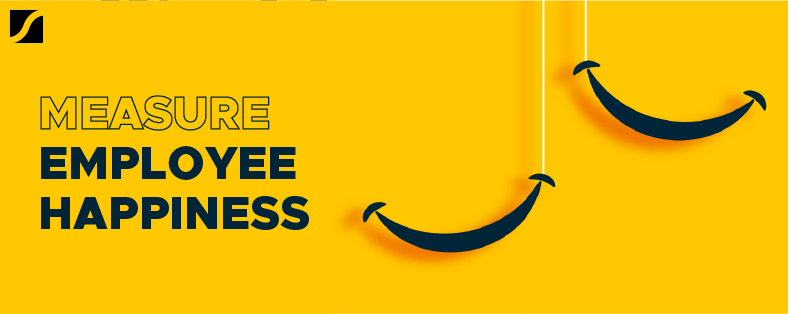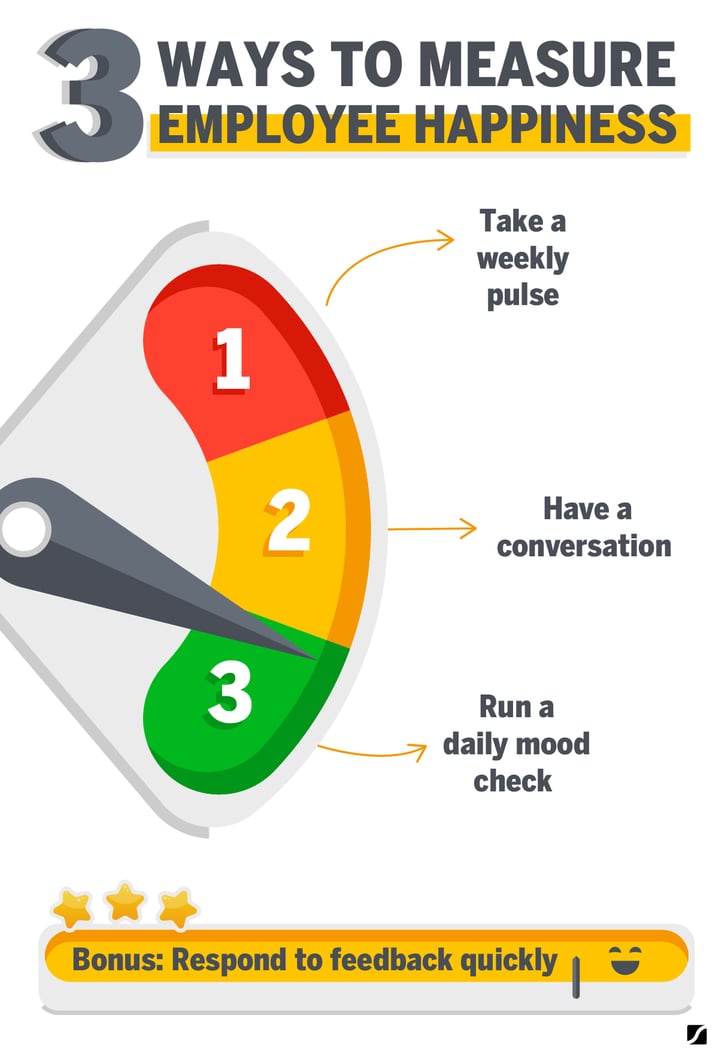3 Ways to Measure Employee Happiness (And 1 Step You Shouldn't Skip)


To build a thriving company, successful business leaders know they need to balance the needs of employees, customers, and shareholders.
Many firms excel at consistently tracking KPIs like profits and customer feedback. But they fall flat when it comes to monitoring employees’ morale - and it shows.
52% of American workers are not engaged in their work and, as a growing body of research has found, employees’ happiness has a direct impact on your company’s performance.
You could keep an eye on morale with annual employee surveys, but that is like driving your car by only looking in the rearview mirror.
By the time you get the results, most of the “accidents” have already happened. Disillusioned employees have alienated good customers, incompetent managers have killed productivity, and the best talent has left for the competition.
Tracking employees’ happiness doesn’t have to be an arduous task. Here's how to simplify your efforts to measure this critical KPI.
One Question To Measure Employee Happiness: The eNPS
Apple and Rackspace use the employee Net Promoter System (eNPS), a metric that is picking up traction, as Fred Reichheld, the intellectual father of the NPS, mentions in his book The Ultimate Question 2.0.
While the well-known NPS tracks customer loyalty, the eNPS measures employees’ engagement and happiness, asking them in a confidential survey:
“On a scale of 0 to 10, how likely is it that you would recommend your workplace to a friend or family member?”
Or a variation of this:
“How happy are you working for [our organization]?
(As Scaling Up Coach John Ratliff discovered at Appletree Answers, the eNPS question may need to be modified when asking employees. It’s not about them recommending their friends, it’s about how happy they are with your company!)
Employees have room to comment, providing additional quantitative data to the survey.
Be prepared: Employees tend to be tough critics. The scores you get from your team are likely to be lower than you get from your customers on the traditional NPS. But if you’re willing to listen, they will tell you what you need to hear.
At the same time, don’t obsess about your scores.
The qualitative data will guide your senior leadership team on how to react to the quantitative data. If the majority of your team is very happy, and only 5% of your employees are grousing about random complaints, you may decide that it isn’t urgent to act on the negative feedback.
But if the comments suggest that the unhappy 5% are all concentrated in a particular department, getting to the bottom of the situation may be an emergency.
3 Ways To Administer the eNPS
What is the right frequency for posing the eNPS question?
Apple asks the question every quarter. Buuteeq, a Seattle-based marketing automation software company, pops the question every month. The frequency you choose depends on what's going on at your company and the pace of change within your culture.
1. Take a weekly pulse
Choose a tool that allows you to measure your team´s morale daily, weekly or at other frequent intervals. It will help you keep levels of engagement high.
TINYPulse, a cloud-based service that sends out weekly survey emails, captures anonymous feedback from employees and offers tools to help management visualize and analyze the data.
When answering the “question of the week,” employees have space to add comments and suggestions.
“Rotating different questions allows us to capture input around the various drivers of employee happiness and gives management more specific information to work with,” explains David Niu, founder and CEO of TINYPulse.
Buuteeq supplements their own monthly eNPS survey with other weekly questions like:
“How likely do you see yourself working here in one year?”
“How does your manager’s leadership style impact on your productivity?”
“What is the one thing we should stop doing to be more successful?”
Align, the software we use at Scaling Up, has the eNPS tool directly embedded in their software.
Users can automate the eNPS survey to go out on a recurring basis to all employees. The software turns that feedback into a trackable metric that can be referenced at any time.
As Doug Walner, Align’s CEO says, “A monthly pulse is valuable, but only if you are hearing from everyone.”
2. Make it a conversation
Buuteeq is transparent about the results, even projecting them onto a wall during its weekly all-hands meeting.
“Sometimes the meeting is almost exclusively about things that came up in the week’s Pulse,” says co-founder and CEO Forest Key. “It is not always easy but we talk things through and often take very specific action - ranging from switching the lunch caterer to strategic changes in our customer service processes.”
No doubt, the company’s discipline in closing the loop with employees every week has encouraged employees to submit the large number of useful suggestions Buuteeq receives through the tool.
The feedback companies receive from tools like TINYPulse is sometimes uncomfortable. Moz used a feature of TINYPulse that allows it to customize questions and allows employees to come up with some that they would like to be asked.
When the company first started with TINYPulse, they received about 500 comments, of which 25 were clearly negative.
“These few negative comments have made me become more nervous and worried about our culture and team happiness,” said Rand Fishkin, Moz's founder. “But I prefer to know and deal with the issues.”
TINYPulse also allows you to comment directly on suggestions and initiate a private, forum-like dialogue with the employee.
Just make sure that you use this part of the system in a way that allows employees to remain anonymous, or they may not want to use it. In very small firms, where there may be only one person in a particular role, it may be easy to guess who made a particular comment.
3. Run a daily mood check
Atlassian, an Australian software company, created an internal app called MoodApp (great name!) for iPads and scattered them throughout their headquarters, including one to the side of the elevator.
On their way out, employees answer questions like “How are you feeling today?” and “Do you think Atlassian is a fun place to work?” A question about how much feedback employees get from their managers uncovered deficits and led the company to use leadership development training to improve the situation.
Does surveying employees this often bug them - and lead them to ignore new questions in the future? So far, that does not seem to be the case. TINYPulse averaged participation rates for the weekly questions at between 55% and 75%. MoodApp average a 60% response rate in its 12 months of life at Atlassian. Larger companies may want to consider sampling smaller groups of respondents to reduce data volumes and avoid survey fatigue.
No Substitute For Meaningful Conversations
If your company isn’t ready to invest in software or iPads for your team, consider a lower-tech approach.
Careesma, a Barcelona-based company that runs job boards across Europe and India, put up a simple bulletin board where employees can leave post-it notes with suggestions. Every week, Tania de la Paz, their head of People & Values, took the notes to weekly staff meetings and maked sure that the management team acted on at least one issue.
In any case, no process or technology should become a substitute for meaningful conversations with your team. Senior leaders should formally visit with one employee each week, the closer to the front lines the better, and ask three simple questions: “What do we need to start doing, stop doing and keep doing?”
Then take a few minutes at the weekly management meeting to share what you’ve learned. There is no need for formal reports. Just sharing anecdotes will do. This qualitative data, collected weekly, will give the senior team a real sense of what’s working and not working among the employees as patterns emerge over weeks and months of conversations.
Add to this feedback by looking at some KPIs such as absenteeism, attrition or tenure with the company, knowledge-sharing activities, training hours, or the number of kudos people give each other.
Make Sure You Respond To Feedback Quickly
Gathering data is useless if you don’t act on it. Nothing is more frustrating than being asked your opinion and then seeing it ignored.
Make sure that you have the management bandwidth to quickly respond to feedback you get.
People are your most valuable assets and are intangible in accounting terms. Measuring their happiness is a way of making them tangible. It will be some time until this type of metric will appear on a balance sheet, but that doesn’t mean you should not pay attention to these measures. They’re some of the best leading indicators of a company´s overall health and value.



